During the middle of the 1960’s, Michigan produced a great number of rock and roll bands. Inspired by the guitar-driven British Invasion groups and the irresistible dance beats of Motown, these young bands played a circuit of newly emerged teen clubs throughout the state. These included, to name just a few, The Hideout in Harper Woods, Band Canyon in Bay City, Mt. Holly in Flint, The Scene in St. Ignace, The Fifth Dimension in Ann Arbor, Sherwood Forest in Davidson, Club Ponytail in Harbor Springs, The Sceen in Lansing, and the Tanz Haus in Traverse City.
Among all of these popular venues, Daniel’s Den located at 2525 State Street in Saginaw stood out as one of the most elegant and well-kept teen night clubs in the state – every bit the equal of the more famous Grande Ballroom in Detroit.
The original Daniel Theatre building was located in northwest Saginaw. Constructed with an art deco design during the golden age of movies, it had become a victim of television during the 1950s like so many neighborhood theatres around the state and nation. By the early 1960s, The Daniel survived by targeting younger audiences with offerings of double features comprised of second and third-run action or comedy movies augmented with cartoons - all for the princely sum of 25 cents. In addition, musician Kenny Roberts often appeared at the theatre during matinees to sing his local hits: “Choc’late Ice Cream Cone” and “Cheer Up, Things Could Be Worse”.
Roberts, billed as “The Jumpin’ Cowboy”, had his own daily children’s television show on WNEM-TV starting in 1961 that featured cartoons and Roberts’ trademark yodeling. The Kenny Roberts Show was popular with Saginaw Valley youngsters, many of whom would become guests in the studio and jump up and down on camera with Kenny while he performed his songs.
By 1964 the Daniel Theatre had three new owners and an idea that would transform the structure. The triumvirate included Saginaw attorney Allan Schmid, local businessman Frank Patrick, and a teacher at Arthur Hill Tech named Bob Parsons. The idea for a non-alcoholic “club” where teens could meet and dance actually came out of a discussion in one of Parsons’ classes. His students complained, “There was nothing to do in Saginaw”, and suggested a place where they could regularly meet and dance. Parsons then took the idea to Patrick and Schmid.
Despite the concern of some community members over the potential for juvenile delinquency, the trio transformed the old Daniel Theatre into a non-alcoholic 'key club' called Daniel’s Den. Based loosely on the concept adopted by the adults-only Playboy Clubs across the country, teens would pay a membership fee and receive an actual key for entry into the club.
Patrick calmed the fears of skeptical members of the Saginaw community by claiming he was attempting to teach young adults the social graces – how to properly engage with the opposite sex. In this spirit, Patrick and his wife Viola concocted non-alcoholic ‘virgin' cocktails, sold at the snack bar at Daniel’s Den, and provided area teens with a safe environment in which to learn how to better socialize with each other.
Daniel’s Den opened for business in 1964. The initial idea of a key club only lasted for a couple of months, however, as the owners found that it was easier and more profitable to simply open the club up to all interested teens.  The line to get into Daniels Den
The line to get into Daniels Den
The music was non-stop at the Den. Club deejays like Bill Eberline, Gary Major, and John Coughlin would spin the Top 40 hits on the nights when no bands were scheduled to play. But the biggest attraction was always the live music. The deejays would also introduce the acts and fill the gaps before each band took the stage and during intermissions with the latest 45s.
Frank Patrick presented an interesting combination of national, regional, and local acts at Daniel’s Den, and people who dealt with Patrick remember him for his iron-clad performance contracts at the club. Ron Cunningham was the drummer for The Del Raes, a popular Bay City band that played many times at Daniel's Den. He remembers Frank Patrick as both frugal and a good businessman. Cunningham has in his possession a cancelled check written by Patrick for $70, the amount the five members of The Del Raes shared for playing one night at the club in 1964.
Cunningham recently told me that his biggest thrill during those days occurred in 1965 on the night that his band was hired to back Sonny & Cher, who were touring behind their # 1 hit, "I Got You Babe". Cunningham fondly remembers the difficulty he had keeping the beat while Cher was singing and shaking her long hair and shapely hips in front of him on the Den's stage.
Although complete booking records no longer exist, Daniel’s Den presented other chart-topping performers of the time such as The Byrds ("Mr. Tambourine Man"), The Human Beinz (“Nobody But Me”) The McCoys (“Hang On Sloopy”), The Kingsmen (“Louie, Louie”), The Electric Prunes (“I Had Too Much To Dream Last Night”), The Lemon Pipers (“Green Tambourine”), The Box Tops (“The Letter”), Gary Lewis and The Playboys (“This Diamond Ring”), Richard & The Young Lions (“Open Up Your Door”), The Strawberry Alarm Clock (“Incense And Peppermints”), The 1910 Fruit Gum Co. (“Simon Says”), The Ohio Express (“Yummy Yummy”), The Gentrys (“Keep On Dancing”), The Shadows Of Knight (“Gloria”), and The Shangri-Las ("Leader Of The Pack").
Patrick also booked some of the leading English artists of the era at Daniel’s Den. These included The Yardbirds (“Heart Full Of Soul”), The Tremeloes (“Silence Is Golden”), and Joe Cocker (“With A Little Help From My Friends”).
Another important ingredient in the success of Daniel's Den came in the unlikely form of two enterprising teenagers named Deb Harden and Jo Hintze. After completing their freshman year at St. Andrew's High School, the girls convinced the editor of The Saginaw News to hire them to write a weekly column featuring their reports on upcoming shows as well as interviews with both the nationally-known and the local musical acts who performed at the Den. Deb and Jo's three-year run of enthusiatic and entertaining articles provided Frank Patrick with an invaluable source of publicity for his teen club. 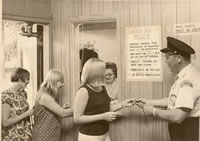 Daniel's Den tickets and rules enforced by Officer Ed
Daniel's Den tickets and rules enforced by Officer Ed
Jo (Hintze) Monday remembers that having a teen nightclub in Saginaw was a new concept, and even though many parents were wondering what was going on inside Daniel's Den, they needn't have worried. Frank Patrick ran a tight ship.
Jo has a photograph of the ticket window inside the venue, and posted next to it are the five Daniel's Den Rules: 1.) Anyone under the influence of alcohol will not be admitted. 2.) You must be 16 yrs. old or in the 10th grade. 3.) Dress - casual but neat and clean. 4.) Absolutely no pass outs. 5.) No beards or sunglasses.
In addition, Saginaw policeman “Officer Ed” Nowaczyk was employed by the Den to enforce the rules and to provide security at the door. According to Mark Sanders, who played at Daniel's Den in Saginaw with The Rogues, Officer Ed had a tried and true move to keep teens who had been drinking out of the venue. Sanders said that the police officer would greet teens entering the club with, "Hello, how are you tonight?" while sticking his nose in their face when they replied so that he could smell any trace of alcohol.
The success of Daniel’s Den led Patrick and Schmid to open teen clubs in Alpena, Houghton Lake, Owosso, Mt. Pleasant, and Lansing. The big name entertainers would usually be booked for more than one appearance at these clubs thereby costing the owners less in performance fees.
According to Donny Hartman, former guitarist and vocalist for the Daniel’s Den house band, Bobby Riggs & the Chevelles , Frank Patrick used some of his contacts with English artists in an attempt to buy The Cavern in Liverpool where The Beatles first rose to fame. Patrick planned to install Hartman’s group as the house band there, but negotiations fell through.  The Rationals performed at The Den
The Rationals performed at The Den
The growth of teen clubs across Michigan coincided with the virtual explosion of rock and roll bands from one end of the state to the other. Daniel’s Den became a popular performance venue for a large number of well-known south Michigan bands including The Bob Seger System, The Amboy Dukes, Tim Tam & The Turn-Ons, The Rationals, The Scot Richard Case (later SRC), The Frost, Third Power, Teegarden & Van Winkle, Brownsville Station, The Sunday Funnies, Plain Brown Wrapper, Savage Grace, The Underdogs, The Prime Movers, and The Woolies.
Deejay John Coughlin remembered that when Bob Seger played Daniel’s Den in the early days, he toured in an old junker of a Chevy station wagon. After the show it had to be pushed by Coughlin and the Den staff so that Seger could pop the clutch and proceed on down the road.
Other popular Michigan bands that performed often at Daniel’s Den and had a number of regional hit singles included Terry Knight & The Pack, The Bossmen, The Motor City Bonnevilles, The Excels from the Upper Peninsula, and WKNX deejay Jay Walker with his band The Jayhawkers.
Saginaw’s Cherry Slush was a band that played regularly at the club. Originally named the Bells Of Rhymny, after a song on the Byrds’ debut album, they first appeared at Daniel’s Den in 1966. After recording the Dick Wagner-penned song “I Cannot Stop You” for their second single, the band decided to change its name to The Cherry Slush. They made the announcement to their Saginaw-area fans in 1967 at Daniel’s Den by playing their first set as The Bells Of Rhymny and then coming out for their second set under their new moniker of The Cherry Slush. 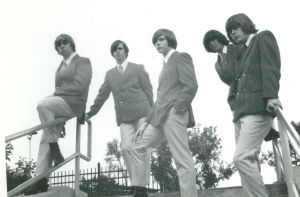 The Cherry Slush from Saginaw
The Cherry Slush from Saginaw
“I Cannot Stop You” was first issued on the small Coconut Groove label out of Mt. Morris, and it became a regional smash before being picked up for national distribution by the USA label based in Chicago. The song would go on to peak at # 119 in Billboard, but it would prove to be The Cherry Slush’s only charting single.
Daniel's Den provided an opportunity for many aspiring groups. The venue hosted its very first "Battle of the Bands" on May 8, 1964, with a showdown between The Neutrons from Bay City and The Maldalians. Within a year, the competitions became a regular attraction at the club. On February 12, 1966, Frank Patrick was quoted in Deb and Jo's column in The Saginaw News; "The exposure the bands are getting is terrific. It's an opportunity of a lifetime to get up on stage and show what you can do. It encourages young people to develop their talents."
There were many other long-forgotten bands that graced the stage at Daniel’s Den. Just a partial list from a few surviving band schedules include The Plagues, The Yorkshires, The Chosen Few, The Blues Company, The Paupers, The Zoo, Bed Of Roses, The Shepherds, The Back Door, The Tempests, The Loose Ends, The Prodigal Sons, The Lovelorns, The Karavans, The Morgues, The Pawns, Hilda Matilda and the Potato Pickers, The Barons, The Us, The Knightsmen, Band X, The Rainmakers, E.J. & The Echos, The Friars, The Merseyside Sound, The Prime Movers, and even some all-girl bands like The Debutantes and The Coquettes. 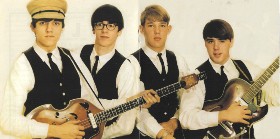 The Plagues
The Plagues
Shepherd & The Flock, a young Bay City band, earned their first gig at Daniel’s Den after winning a Roll-Air Battle of the Bands competition the previous summer. Located on State Park Drive in Bay City, the outdoor venue’s band competitions were sponsored by WKNX-AM and were presented by two of the station’s deejays, Bob Dyer and Dick Fabian. Besides the glory of winning the prestigious event, WKNX also set up some gigs for the winning band, one of which was a performance as an opening act at the Y A-G-Go, a rival teen dance club that operated at the Saginaw Y.M.C.A. and was hosted by Dyer and Fabian.
John Hebert, Shepherd & The Flock’s 14-year-old guitarist, was too young to attend shows at Daniel’s Den prior to getting the chance to perform there with his band. He remembers that the building had a lobby with a snack bar, but all of the theatre seats had been removed so that teens had room to dance and socialize. The bands played on an elevated stage at the end of the building where the movies used to be projected. The stage was also equipped with large curtains that would open when the groups were introduced and close at the end of each set. Those that went there also remember the Den’s pool tables and the bathrooms located upstairs, not to mention the steady stream of girls primping in front of the mirrors for the boys down below.
Bo White’s first exposure to the music of Daniel’s Den came while working as a teen for his dad at White’s Bar. His job was to patrol the back parking lot at White’s which was located adjacent to Daniel’s Den. Armed with a flashlight he would inform Den patrons not to park in the White’s lot. But it wasn’t long before the music coming out of the venue’s back door lured Bo into becoming a regular at the teen club himself.
During his presentation on Daniel’s Den at the Castle Museum in Saginaw, White related how the atmosphere in the club began to change as the decade drew on and the music began to evolve. The kids had stopped dancing and began to just watch the bands perform on stage. By this time the Den had its own psychedelic light show that was projected behind the groups as they played their sets.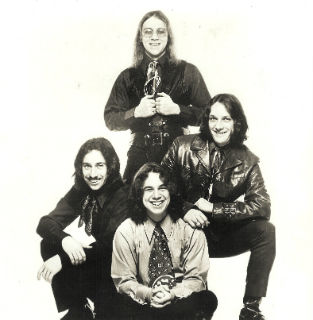 The Frost
The Frost
The original Daniel's Den in Saginaw lasted from 1964 to 1970. By the end of the decade Bob Parsons had become a little disillusioned as he saw the emphasis shift from the music to money. The bands wanted more and so did the owners, who now looked at it as more of a business as opposed to Frank Patrick’s original concept. As a result, the teen club was not as much fun as it had been. Drugs had also started coming in and were harder to monitor. There were never any big problems at Daniel’s Den, however, and none of the many concerts and events there were ever violent or unruly.
In 1971 and 1972, the venue reopened under new ownership. Its name was changed to FDM, which stood for "Fun, Music and Dancing". Fred DeMaet was the man who ran the club during those years.
Before closing its doors for good as a teen dance club in 1973, Elmar Paeva operated the business in its final appellation as Elmar’s Den. Paeva, who is currently one of the owners of the Retro Rocks bar in Saginaw, has probably the only film footage shot inside Daniel’s Den that is known to exist. According to Bo White, Elmar filmed a performance of Iggy Pop with The Stooges in late 1969 or early 1970, shortly before the original version of the venue closed its doors.
Original owner Allan Schmid died several years ago and his partner Frank Patrick passed away in 2009. Bob Parsons is retired and no longer lives in Saginaw. The building that housed one of Michigan’s greatest rock and roll clubs for teens was demolished in 1988.
The property where the once-proud structure stood is now occupied by the parking lot and building that houses Charter Communications. On the day I visited the Charter facility, its lobby was filled with people. There were no photographs of Daniel’s Den, and I doubt if any of the customers who were crammed shoulder-to-shoulder in the tiny waiting area had any idea that they were standing near to where the Den’s stage was once located. 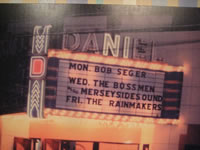 Photo of the Daniel's Den marquee in White's Bar
Photo of the Daniel's Den marquee in White's Bar
The only visible traces of Daniel’s Den left in Saginaw is on the walls of its old neighbor, White’s Bar. There you can find a photo of the Den’s marquee as well as a number of publicity shots of several of the bands that played there over forty years ago.
Suzanne Blair, who currently works as a daytime bartender at White’s, vividly remembers her days as a regular at Daniel’s Den. Suzanne, who grew up in Saginaw Township, recalled that she used to get rides to the Den from her older sister almost every weekend. She also revealed how excited she was to be offered a job as the coat check girl, which meant that she would no longer have to pay admission into the club and would even make a little money while spending her weekends at the coolest place in town.
Blair mentioned that sometimes the photographs on the walls will spark a discussion among the bar patrons about the good times at Daniel’s Den or of the bands that they saw perform there.
Unfortunately, it’s a scenario common to the many cities in Michigan that hosted teen night clubs during the 60’s. In most cases the only things left of this vital musical period are the memories of those who were there. Little thought was given to preserving the places and the memorabilia associated with the teen clubs, and there seems to be hardly any interest on the part of local or state governmental agencies in collecting materials or documenting this unique cultural phenomenon in which Daniel’s Den played an important role.

